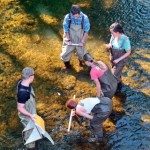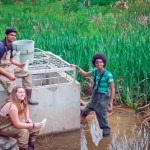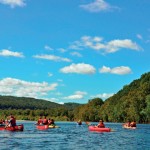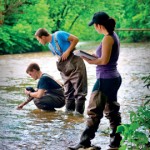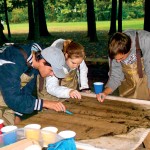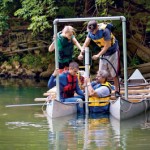Home Base, Global Reach
By Robin Rogers | Photography by Chuck Zovko
Gravity pulls raindrops and snowflakes from the sky into the Catskill Mountains of New York, into stands of ash trees that spawned Louisville Slugger baseball bats, into dense conifer forests that provided the first Christmas trees sold on a New York City street corner in the 1800s, and onto sandstone and shale from ancient seas. The rain and melting snow drain down the western mountain slopes to form the Delaware River Basin. The watershed supplies more than 15 million people with water.
Lafayette’s campus on College Hill overlooks the confluence of two of the basin’s major rivers, the mighty Delaware itself—longest undammed river east of the Mississippi—and the Delaware’s second-largest tributary, the Lehigh. Closer still to the College flows the Bushkill Creek, making its way under the Williams Arts Campus on North Third St. before spilling into the Delaware. The College’s location provides distinctive opportunities for environmental studies and research.
Lafayette in the World
View an interactive map of the locations around the world where Lafayette’s influence has an ongoing impact.
“Living at the confluence of the rivers, for me it’s fabulous,” says Dru Germanoski, Van Artsdalen Professor of Geology and Environmental Geosciences. “It’s a natural laboratory on or near campus.”
“It provides an opportunity to engage students immediately,” he adds. “They can know the geography and can recognize what we’re talking about. We approach global issues through a multidisciplinary lens focused at a local level. It brings our work to life.”
The riverine resources give the teachers better tools to use as educators, empowering them to provide greater experiential learning for students. Recently, these activities have focused on the potential effects of dam removal, how geologic chemistry reveals pollution in soil and water, what’s in treated wastewater effluents, and how invasive species impact native wildlife.
We are reminded by David Brandes, professor of civil and environmental engineering, that rivers, canals, and railroads helped Easton become a major commercial center and transportation hub for the steel and coal industries in the 19th century. (Lafayette, in turn, became one of the first American colleges to address the needs of the Industrial Revolution by adding civil and mining engineering to the traditional classical curriculum in 1866.) One effect of industrialization was the erection of dams along the Bushkill Creek to support water-powered mills that helped process grain, lumber, silk, and flax.
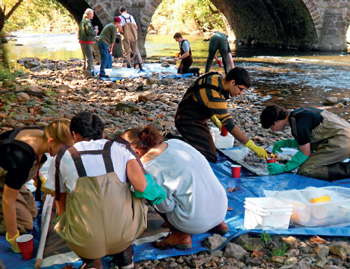
Olivia Jurewicz ’15 (L-R), Ashley Bohnenberger ’15, Arin Stasco ’14, Gabriel Hernandez ’15, and Michael Ryan ’15 examine and identify macroinvertebrates gathered from Bushkill Stream during lab for Kney’s introduction to environmental engineering and science.
“Dams can deteriorate water quality, create a deficit of oxygen, slow velocity, and fragment the habitat for wildlife such as trout, instigating a push towards dam removal in Pennsylvania,” says Megan Rothenberger ’02, assistant professor of biology. One of Rothenberger’s studies concluded that the quality of the water above a dam on the lower Bushkill had deteriorated; it was murky with arsenic, cadmium, copper, and lead, and therefore detrimental to native macroinvertebrates, an indicator species. One proposed solution was to dredge behind the dam to remove polluted sediments prior to dam removal.
Brandes advocates removing “orphan” dams—dams with no owner of record—because they are good neither for fishermen and kayakers, nor for shad and trout, nor for eagles and osprey that feed on the fish. As a student, Maricate Conlon ’11 worked with Brandes and Germanoski to measure the concentrations of heavy metals in legacy sediment behind the Third Street Dam along the Bushkill. They discovered that the concentration levels wouldn’t pose hazards if they were released.
Conlon is among many talented students interested in environmental issues who have been attracted to the College by the opportunities its location provides. She believes the field research she did here contributed to being well-prepared for graduate studies and her career. She majored in geology at Lafayette, received the Class of 1913 Trophy as the woman senior who achieved the greatest distinction as an athlete and a scholar (her sport was swimming), earned a master’s degree at Boston College, and is now a geologist with an international environmental consultancy.
Germanoski employs the Bushkill in all of his environmental courses, partly, he says, because it’s shallow enough to wade in for testing. The creek allows students to see how the chemistry changes and how typical pools and riffles function to reoxygenate the water for aquatic life.
Brian Schubert ’04, who majored in geology and minored in environmental science, recalls researching with Germanoski how sediments in the Bushkill are transported and how they are affected by land-use practices. “Too much runoff from farms can cause algal blooms that deplete oxygen,” he explains, “and too much construction runoff can provide too much sediment that then chokes out wildlife.”
Field trips to the Delaware Water Gap—where the Delaware spills through an opening in the Kittatiny Ridge, where the mountain-building pressures that crumpled and folded the layers of rock millions of years ago are plainly revealed—were a van ride away. Schubert’s undergraduate research “opened the doors of opportunity,” he says, helping propel him toward doctoral studies at Binghamton University, to post-doc research at University of Hawaii, to field work in Canada, Ireland, and Alaska, in Death Valley and in Siberia. He’s now on the faculty of the School of Geosciences at University of Louisiana at Lafayette. “My Lafayette experience informs my own teaching,” he says.
Working with Brandes, Alec Bernstein ’11 used hydraulic modeling to assess the potential effects of removing a small relic dam along the Bushkill. His undergraduate research and work with Lafayette’s chapter of Engineers Without Borders establishing a clean-water system in rural Honduras inspired his passion to work with water resources. A civil engineering graduate, he went on to earn an M.S. in environmental and water resources engineering at University of Massachusetts, Amherst, then worked in Kolkata, India, on a Fulbright Grant, evaluating the sustainability of water and sanitation systems. He’s now a water resources engineer in Seattle. “It all started on Bushkill Creek,” he says.
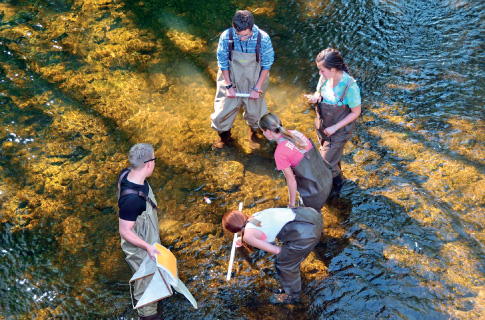 Keven Yell ’15 (clockwise from top), Lindsay Marko ’14, Elisabeth Burnor ’14, Kristen Propst ’14, and Alexander Huntowski ’14—a collaborative team from environmental issues in aquatic ecosystems and introduction to environmental engineering—measure water velocity.
Keven Yell ’15 (clockwise from top), Lindsay Marko ’14, Elisabeth Burnor ’14, Kristen Propst ’14, and Alexander Huntowski ’14—a collaborative team from environmental issues in aquatic ecosystems and introduction to environmental engineering—measure water velocity.
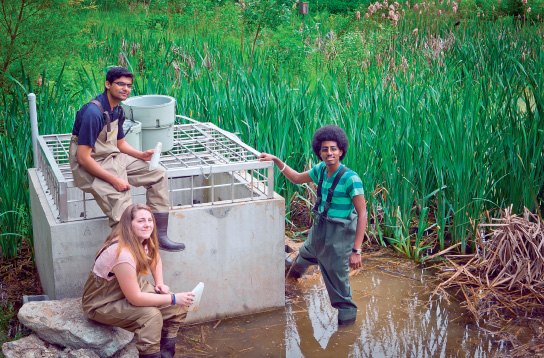 Hassaan Khan ’13 (L-R), Hannah Griesbach ’13, and Leikune Aragaw ’15 collect water samples and computer data at Sullivan Park constructed wetland.
Hassaan Khan ’13 (L-R), Hannah Griesbach ’13, and Leikune Aragaw ’15 collect water samples and computer data at Sullivan Park constructed wetland.
 Students in the cultures of nature course, which bridges environmental science and literature, paddle along the Delaware River.
Students in the cultures of nature course, which bridges environmental science and literature, paddle along the Delaware River.
 In a summer research project, Joshua Hitchings ’14, Bradley Ohlinger ’13, and Prof. Rothenberger measure water velocity, pH, dissolved oxygen, and temperature below a Bushkill Stream dam proposed for removal. The long-term study will be the longest pre-removal monitoring dataset ever recorded. A biology honors graduate, Hitchings’ thesis was on the impact of small dams on water quality and macroinvertebrates in the Bushkill.
In a summer research project, Joshua Hitchings ’14, Bradley Ohlinger ’13, and Prof. Rothenberger measure water velocity, pH, dissolved oxygen, and temperature below a Bushkill Stream dam proposed for removal. The long-term study will be the longest pre-removal monitoring dataset ever recorded. A biology honors graduate, Hitchings’ thesis was on the impact of small dams on water quality and macroinvertebrates in the Bushkill.
 Michael Fogarty ’17, Alexandra Beyer ’17, and Dylan Hahn ’17 identify macroinvertebrates.
Michael Fogarty ’17, Alexandra Beyer ’17, and Dylan Hahn ’17 identify macroinvertebrates.
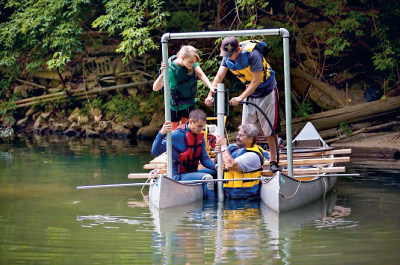 Maricate Conlon ’11 (clockwise from left), Tyler Germanoski ’12, Professor Germanoski, and Michael Thompson ’12 conduct study on Bushkill Stream about the implications of removing the dam near Third Street.
Maricate Conlon ’11 (clockwise from left), Tyler Germanoski ’12, Professor Germanoski, and Michael Thompson ’12 conduct study on Bushkill Stream about the implications of removing the dam near Third Street.
IMPROVING WASTEWATER TREATMENT
“We tie our work to the bigger picture,” says Art Kney, associate professor of civil and environmental engineering. He recently brought students and faculty together to study effluents from the City of Easton’s wastewater treatment plant. The goal: develop a plan for a wastewater treatment test facility that uses realistic field conditions.
The implications could be huge, Kney says. The American Society of Civil Engineers gave the nation’s wastewater and stormwater systems a grade of D in its 2013 Report Card for America’s Infrastructure, estimating capital investment needs for these systems at $298 billion over the next 20 years. Expenditures for secondary and tertiary wastewater treatment add up to more than $100 billion nationally.
Taking Action
SEES (Society of Environmental Engineers and Scientists) conducts research on environmental science and engineering problems and promotes environmental sustainability. Founded in 2004, the group received an EPA grant for an arsenic treatment project. They established a composting program for the College and LaFarm, a two-acre community garden and working farm at Metzgar Fields.
LEAP (Lafayette Environmental Awareness and Protection) is dedicated to making the College more sustainable and decreasing its ecological footprint. The group is involved with LaFarm and the College’s sustainability committee as well as local environmental organizations.
Because there are virtually no generally available facilities for researchers and industries to test and develop wastewater technologies under realistic field conditions, having such a facility in Easton would position the Lehigh Valley as a major player in advanced wastewater treatment technologies.
Liekune Aragaw ’15 says his collaboration with Kney in a study of nutrients in effluent from the wastewater treatment plant in nearby Nazareth helped him visualize a future combining environmental studies with engineering and architecture. He came to Lafayette from his native Ethiopia specifically for the opportunity to research and work with faculty as an undergraduate civil engineering major.
Emily Crossette ’15 grew up visiting her grandmother who lives along the Delaware, not far from Easton. She was “blissfully unaware of the contemporary environmental challenges to maintaining water quality” while she was kayaking, swimming, and tubing at the time, but now is focused on how she can “contribute to protecting these waters.” Working with Kney, the civil engineering major studied the impact of endocrine-disrupting compounds, released by wastewater treatment plants, which cause mutations in fish—a global problem. She was awarded a Udall Scholarship and U.S. Environmental Protection Agency fellowship to support the research.
BATTLING INVASIVE SPECIES
Invasive species of plants (such as purple loosestrife, Japanese knotweed, Japanese stilt grass, and Japanese barberry), animals (such as red-eared slider turtle), and insects (hemlock woody adelgid) pose a threat to the unique ecosystems around Easton. Purple loosestrife, for example, pleasing to look at, elbows out everything in its path to create a monoculture, thereby decreasing native insects, birds, and plants that depend on each other for survival.
“We rent a bus to take students to see wetlands and the confluence of the rivers. Experts and environmental educators speak as we ride, touching on chemistry, biology, hydraulics, and more.”
—Art Kney and David Brandes
Rothenberger, whose work straddles biology and geology, often takes her students to Jacobsburg Environmental Education Center, a state park north of Easton in Northampton County, where the Bushkill flows and park rangers are undertaking initiatives to manage invasive species.
A mere quarter-mile from campus, Sullivan Park was named 2014 Green Park of the Year in Pennsylvania thanks in large part to the work of Brandes and his students. Under Brandes’ guidance, students installed a constructed wetlands there, mitigating a serious water runoff problem, and planted native vegetation. While the City of Easton was the official recipient of the state’s top conservation award, the Bushkill Stream Conservancy, Northampton County Conservation District, and Lafayette all played a role in transforming the perpetually soggy park into a sustainable showcase that now serves as an outdoor classroom for area schools. Dealing with invasive species is a challenge there, too.
“Part of our management plan,” Brandes says, “is to pull invasives out by hand to let the native plants thrive.”
BROAD VIEWS
“We define sustainability from a watershed perspective to get a bigger picture of impacts on water quality. For example, if one municipality uses salts on the roads, we would see different impact results than if a municipality is pristine. We also look at the dynamics of regulations and how municipalities can work together,” Brandes says.
“These rivers connect us to other places, too,” he observes. “New York City is linked to the Delaware River Basin, as is Philadelphia, so there’s a tangible connection between Easton and the larger metropolitan areas.”
In fact, about half of New York City’s water supply comes from the Delaware River Basin. Steven Schindler ’81 is director of water quality in the city’s Department of Environmental Protection. In 2013 the department was presented with the American Water Works Association’s Exemplary Source Water Protection Award, which recognizes organizations for outstanding source-water protection programs for drinking-water supplies.
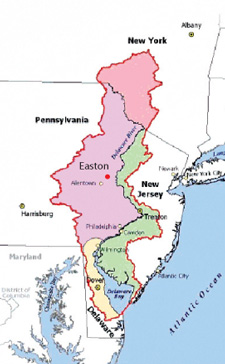
Delaware River Watershed
Just as the minor rivulets and streams of the Catskills eventually form the larger waterways around Easton, small environmental ripples have the ability to lead to big results. Lafayette’s partnerships with local environmental organizations (such as the Bushkill Conservancy and Nurture Nature Center), government organizations, and private industry promise to accelerate positive environmental changes.
Raising $70 million for an integrated, broadly interdisciplinary sciences center is a key priority of the College’s $400 million Live Connected, Lead Change campaign. Germanoski has the added hope of seeing a full environmental field station on the Bushkill Creek one day to bring the classrooms even closer to the field.
Bernstein remembers the “best class ever”—a tubing adventure with Brandes on the Delaware that gave him an otter’s-eye view of the river. “We talked about drinking water, how reservoirs control flow, regulatory policies,” Bernstein says. “I appreciated being able to see it up close.”
Brandes says, “If I had my way, every student would take a trip down the river.”
//
